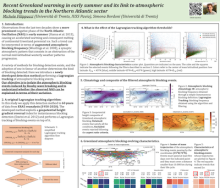Recent Greenland warming in early summer and its link to atmospheric blocking trends in the Northern Atlantic sector
Michele
Filippucci
University of Trento
Poster
In recent decades, a more prominent negative phase of summer NAO has been observed (Hanna et al. 2015). While evident in observations, this signal does not emerge in model projections of future climate. Therefore, the attribution of the observed trend to internal variability or to anthropogenic forcing is a topic of growing debate. Improved understanding of the recent NAO shift is urgent, given its several impacts on the climate system, such as temperature extremes at high latitudes and a pronounced acceleration of Greenland ice melting.
In this work, we try to achieve a better understanding of the concurrent causes of the observed trend by analyzing Greenland atmospheric blocking, a synoptic phenomenon that strongly anticorrelates with NAO. We choose to focus our analysis on blocking events resulting from the cyclonic breaking of Rossby waves in the Northern Atlantic. For these purposes, we develop an original Lagrangian tracking algorithm for atmospheric blocking detection based on the geopotential height gradient reversal (Davini et al. 2012), which allows us to compute the blocking events number, area, persistence and average displacement.
Results confirm how the occurence of Greenland atmospheric blocking is increasing. The frequency trend is attributed to an increased number of blocking events in summer, rather than an increased persistence, suggesting a change in the triggering mechanism. In addition, a diminuished number of blocking events in spring emerges, together with a decreased spring blocking persistence. Moreover, we apply a zonal-blocked flow decomposition to investigate to what extent the emergent mean summer geopotential height anomaly can be attributed to blocking or to mean state differences. The decomposition highlights how the anomaly is strong even in the days not interested by atmospheric blocking and how the increased frequency is rather acting as a positive feedback mechanism of the negative NAO phase.
In this work, we try to achieve a better understanding of the concurrent causes of the observed trend by analyzing Greenland atmospheric blocking, a synoptic phenomenon that strongly anticorrelates with NAO. We choose to focus our analysis on blocking events resulting from the cyclonic breaking of Rossby waves in the Northern Atlantic. For these purposes, we develop an original Lagrangian tracking algorithm for atmospheric blocking detection based on the geopotential height gradient reversal (Davini et al. 2012), which allows us to compute the blocking events number, area, persistence and average displacement.
Results confirm how the occurence of Greenland atmospheric blocking is increasing. The frequency trend is attributed to an increased number of blocking events in summer, rather than an increased persistence, suggesting a change in the triggering mechanism. In addition, a diminuished number of blocking events in spring emerges, together with a decreased spring blocking persistence. Moreover, we apply a zonal-blocked flow decomposition to investigate to what extent the emergent mean summer geopotential height anomaly can be attributed to blocking or to mean state differences. The decomposition highlights how the anomaly is strong even in the days not interested by atmospheric blocking and how the increased frequency is rather acting as a positive feedback mechanism of the negative NAO phase.

Poster file
Filippucci_Michele_blocking_poster_0.pdf
(13.23 MB)
Meeting homepage
